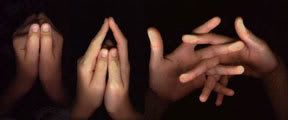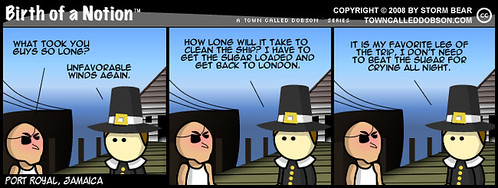 click to enlarge The most famous triangular trade in human history was the 18th century trade between West Africa, the West Indies, and Europe (alternatively: West Africa, the West Indies, and northern colonies in British North America). Of these, the sea lane west from Africa was the notorious Middle Passage; its cargo, abducted or recently purchased African slaves. The trade represented a profitable enterprise for merchants. The business was risky, competitive, and severe, but enslaved Africans fetched a high price at auctions, making the trade in human cargo a lucrative business. European colonists initially practiced systems of both bonded labor and Indian slavery, enslaving many of the natives of the New World. For a variety of reasons, Africans replaced Indians as the main population of slaves in the Americas. In some cases, such as on some of the Caribbean Islands, disease such as smallpox and warfare eliminated the natives completely. In other cases, such as in South Carolina, Virginia, and New England, the need for alliances with native tribes coupled with the availability of African slaves at affordable prices (beginning in the early 18th century for these colonies) resulted in a shift away from Indian slavery. It is often falsely claimed that Indians made poor slaves compared to Africans, explaining the shift to using Africans. The reasons had more to do with economics and politics. The first leg of the triangle was from a European port, where supplies such as copper, cloth, trinkets, slave beads, guns and ammunition would be shipped to a port in Africa. When the slave ship arrived, its cargo would be sold in exchange for slaves, who were often tightly-packed like any other cargo to maximize profits. The ship would then make the journey along the Middle Passage to the New World. Once the slave ship reached the New World, the survivors would be sold for a good profit. The ships were then prepared to get them thoroughly cleaned, drained, and loaded for a return voyage to their home port. A burial ground in Campeche, Mexico, suggests slaves had been brought there not long after Hernán Cortés completed the subjugation of Aztec and Mayan Mexico. The graveyard had been in use from about 1550 to the late 1600s. The first side of the triangle was the export of goods from Europe to Africa. A number of African kings and merchants took part in the trading of slaves from 1440 to about 1900. For each captive, the African rulers would receive a variety of goods from Europe. Many of them were confronted with the dilemma of trading with Europe or becoming slaves themselves. The second leg of the triangle exported enslaved Africans across the Atlantic Ocean to South America, the Caribbean islands, and North America. The third and final part of the triangle was the return of goods to Europe from the Americas. The goods were the products of slave-labor plantations and included cotton, sugar, tobacco, molasses and rum. From the West Indies the main cargo was sugar, rum, and molasses; from Virginia, it was tobacco and hemp. The ship then returned to Europe to complete the triangle. Alternatively, New England also benefited from the trade, as many merchants were from New England, especially Rhode Island, replacing the role of Europe in the triangle. New England also made rum from the Caribbean sugar and molasses, which it shipped to Africa as well as within the New World. However, Brazil (the main importer of slaves) manufactured these goods in South America and directly traded with African ports, thus not taking part in a triangular trade. Disclaimer:
|
Friday, March 28, 2008
Black History: Triangular Trade
Posted by
Storm Bear
at
7:44 AM
0
comments
![]()
Labels: Africa, cartoons, comics, middle passage, slavery, triangular trade, webcomics
Thursday, March 27, 2008
Black History: Sailing To Arabia
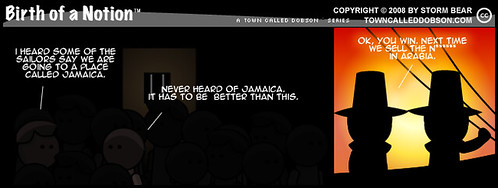 click to enlarge Subscribe to Town Called Dobson by Email! In order to achieve profit, the owners of the ships divided their hulls into holds with little headroom, so they could transport as many slaves as possible. Unhygienic conditions, dehydration, dysentery and scurvy led to a high mortality rate, up to a third of captives. Only the most resilient survived the transport. Often the ships transported hundreds of slaves, who were chained tightly to plank beds. For example, the slave ship "Henrietta Marie" carried about 200 slaves on the long Middle Passage. They were confined to cargo holds with each slave chained with little room to move. The most important routes of the slave ships led from the northern and middle coasts of Africa to South America and the south coast of what is today the Caribbean and the United States of America. The captains and sailors of the boats were allowed to do whatever they wanted with the slaves. This included rape, murder, and torture because the slaves were considered their property. As many as 20 million Africans were transported by ship. The transportation of slaves from Africa to America was known as the Middle Passage. The African slave trade was outlawed in 1807, by a law passed jointly in the United States of America and the United Kingdom, the applicable UK Act was the Abolition of the Slave Trade Act and outlawed slavery throughout the British Empire. The US law took effect on January 1, 1808. After that date all US and English slave ships leaving Africa were legally pirate vessels subject to capture by the American and British navies. It was 1815 at the Council of Vienna before Spain, Portugal, France and The Netherlands agreed to abolish their slave trade. During this time, the slave ships became smaller and more cramped in exchange for improved performance in their new role as smuggling craft and blockade runners. Only a few decades after the discovery of America by Europeans, demand for cheap labor to work plantations made slave-trading a profitable business. The peak time of slave ships to the Atlantic passage was between the 17th and 18th century when large plantations developed in the English colonies of North America. The Arab slave trade was the practice of slavery in West Asia, North Africa, East Africa, and certain parts of Europe (such as Sicily and Iberia) during their period of domination by Arab leaders. The trade mostly involved North and East Africans and Middle Eastern peoples (Arabs, Berbers, Persians, etc.). Also, the Arab slave trade was not limited to people of certain color, ethnicity, or religion. In the early days of the Islamic state—during the 8th and 9th centuries—most of the slaves were Slavic Eastern Europeans (called Saqaliba), people from surrounding Mediterranean areas, Persians, Turks, other neighbouring Middle Eastern peoples, peoples from the Caucasus Mountain regions (such as Georgia and Armenia) and parts of Central Asia (including Mamluks), Berbers, and various other peoples of varied origins as well as those of Black African origins. Later, toward the 18th and 19th centuries, slaves increasingly came from East Africa. Some historians estimate that between 11 and 18 million black African slaves crossed the Red Sea, Indian Ocean, and Sahara Desert from 650 CE to 1900 CE, or more than the 9.4 to 14 million Africans brought to the Americas in the Atlantic slave trade. The medieval slave trade in Europe was mainly to the East and South: The Byzantine Empire and the Muslim World were the destinations, pagan Central and Eastern Europe an important source. Slavery in medieval Europe was so common that the Roman Catholic Church repeatedly prohibited it— or at least the export of Christian slaves to non-Christian lands was prohibited at, for example, the Council of Koblenz in 922, the Council of London in 1102, and the Council of Armagh in 1171. Viking, Arab, Greek and Jewish merchants (known as Radhanites) were all involved in the slave trade during the Early Middle Ages. So many Slavs were enslaved that the very name 'slave' was derived from their name; not only in English, but in other European languages and Arabic as well. Periodic raiding expeditions were sent from Islamic Iberia to ravage the Christian Iberian kingdoms, bringing back booty and slaves. In a raid against Lisbon in 1189 CE, for example, the Almohad caliph Yaqub al-Mansur took 3,000 female and child captives, while his governor of Córdoba, in a subsequent attack upon Silves in 1191 CE, took 3,000 Christian slaves. According to Robert Davis between 1 million and 1.25 million Europeans were captured by Barbary pirates, who were vassals of the Ottoman Empire, and sold as slaves between the 16th and 19th centuries. This considerably exceeds the figure of 645,000 Africans who were brought to what is now the United States. These slaves were captured mainly from seaside villages from Italy, Spain, Portugal and also from more distant places like France or England, the Netherlands, Ireland and even Iceland and North America. The impact of these attacks was devastating – France, England, and Spain each lost thousands of ships, and long stretches of the Spanish and Italian coasts were almost completely abandoned by their inhabitants. Pirate raids discouraged settlement along the coast until the 19th century. The Ottoman wars in Europe and Tatar raids brought large numbers of Christian slaves into the Islamic world too. The 'Oriental' or 'Arab' slave trade is sometimes called the 'Islamic' slave trade, but a religious imperative was not the driver of the slavery, Patrick Manning, a professor of World History, states. However, since if a non-Muslim population refuses to adopt Islam or pay the Jizzya protection/ subjugation tax, that population is considered to be at war with the Muslim "ummah" and therefore it becomes legal under Islamic law to take slaves from that non-Muslim population. Usage of the terms "Islamic trade" or "Islamic world" has been disputed by some Muslims as it treats Africa as outside of Islam, or a negligible portion of the Islamic world. Propagators of Islam in Africa often revealed a cautious attitude towards proselytizing because of its effect in reducing the potential reservoir of slaves. Disclaimer:
|
Posted by
Storm Bear
at
6:25 AM
0
comments
![]()
Labels: Africa, arabia, cartoons, comics, slave ships, slavery, webcomics
Wednesday, March 26, 2008
Black History: Sailing to the New World
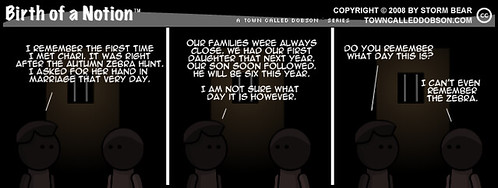 click to enlarge Subscribe to Town Called Dobson by Email! The trade of enslaved Africans in the Atlantic has its origins in the explorations of Portuguese mariners down the coast of West Africa in the 15th century. Before that, contact with African slave markets was made to ransom Portuguese that had been captured by the intense North African Barbary pirate attacks to the Portuguese ships and coastal villages, frequently leaving them depopulated. The first Europeans to use African slaves in the New World were the Spaniards who sought auxiliaries for their conquest expeditions and laborers on islands such as Cuba and Hispaniola, where the alarming decline in the native population had spurred the first royal laws protecting the native population (Laws of Burgos, 1512-1513). The first African slaves arrived in Hispaniola in 1501. After Portugal had succeeded in establishing sugar plantations (engenhos) in northern Brazil ca. 1545, Portuguese merchants on the West African coast began to supply enslaved Africans to the sugar planters there. While at first these planters relied almost exclusively on the native Tupani for slave labor, a titanic shift toward Africans took place after 1570 following a series of epidemics which decimated the already destabilized Tupani communities. By 1630, Africans had replaced the Tupani as the largest contingent of labor on Brazilian sugar plantations, heralding equally the final collapse of the European medieval household tradition of slavery, the rise of Brazil as the largest single destination for enslaved Africans and sugar as the reason that roughly 84% of these Africans were shipped to the New World. Merchants from various European nations were later involved in the Atlantic Slave trade: Portugal, Spain, France, England, Scotland, Brandenburg-Prussia, Denmark, Holland. As Britain rose in naval power and settled continental north America and some islands of the West Indies, they became the leading slave traders. At one stage the trade was the monopoly of the Royal Africa Company, operating out of London, but following the loss of the company's monopoly in 1689, Bristol and Liverpool merchants became increasingly involved in the trade. By the late 17th century, one out of every four ships that left Liverpool harbour was a slave trading ship. Other British cities also profited from the slave trade. Birmingham, the largest gun producing town in Britain at the time, supplied guns to be traded for slaves. 75% of all sugar produced in the plantations came to London to supply the highly lucrative coffee houses there. In general, early Christians, such as Paul, St. Augustine, or St. Thomas Aquinas did not oppose slavery. Pope Nicholas V even encouraged enslaving non-Christian Africans in his Papal Bull Romanus Pontifex of 1454. Since then other popes stated that slavery was against Christian teachings, as is now generally held. Even earlier, in 1435, Pope Eugene IV condemned the enslavement of the inhabitants of the Canary Islands. A list of papal statements against slavery (and also claims that the popes nonetheless owned and bought slaves) is found in the discussion Christianity and Slavery. Most Christian sects found some way to soothe the consciences of their slave-owning members. One notable exception was the Society of Friends (Quakers), who advocated the abolition of slavery from earliest times. The first slaves to arrive as part of a labor force appeared in 1502 on the island of Hispaniola (now Haiti and the Dominican Republic). Cuba received its first four slaves in 1513. Slave exports to Honduras and Guatemala started in 1526. The first African slaves to reach what would become the US arrived in January of 1526 as part of a Spanish attempt at colonizing South Carolina near Jamestown. By November the 300 Spanish colonist were reduced to a mere 100 accompanied by 70 of their original 100 slaves. The slaves revolted and joined a nearby native population while the Spanish abandoned the colony altogether. Colombia received its first slaves in 1533. El Salvador, Costa Rica and Florida began their stint in the slave trade in 1541, 1563 and 1581 respectively. The 17th century saw an increase in shipments with slaves arriving in the English colony of Jamestown, Virginia in 1619. Irish immigrants brought slaves to Montserrat in 1651. And in 1655, slaves arrive in Belize. Disclaimer:
|
Posted by
Storm Bear
at
6:13 AM
0
comments
![]()
Labels: Africa, cartoons, christianity, comics, middle passage, quakers, slavery, webcomics
Here is the church...
Originally posted at Howard-Empowered People
"You don't choose your family, but you choose what church you want to attend."(Shakes head)
Here is the church, and here is the steeple All the people, Hillary. Not just the pastor. Setting aside for a moment the concepts of forgiveness and redemption, and, oh, I don't know, choosing to stay with someone who's made a mistake of some sort, disagreeing with one's pastor is not necessarily reason enough to leave one's church home. As Deborah Brown said at Street Prophets yesterday More here. |
Tuesday, March 25, 2008
Election 08, Blogging For Voter Justice, Concede Now Hillary
Blogging for Voter Justice 1. She can’t win the nomination without overturning the will of the elected delegates, which will alienate many Democrats. 2. She can’t win the nomination without a bloody convention battle — after which, even if she won, history and many Democrats would cast her as a villain. 3. Catching up in the popular vote is not out of the question — but without re-votes in Florida and Michigan it will be almost as impossible as catching up in elected delegates. The others you can read HERE.I could give her (Hillary Clinton) some advice on how to bow out gracefully but she has already received plenty of that. I could talk about Team Clinton's color aroused tactics of "darkening the tone of Barack Obamas skin in TV attack ads, but you know about that too. I could also talk about how Lenora Fulani is running for President as an independent and has charged Hillary with color aroused campaigning, but I won't I could talk about how Team Clinton have swift boated Barack more than any republican thus far, but you know that as well. So... What can I really talk about. I can't talk about Hillary Clinton's real problems? Pam over at Pam's House Blend has that covered. Should I talk about Hillary Clinton's "Bosnia Sniper fire" Lie, probably not plenty bloggers are talking about her getting caught Up In Her Own Lies:. So what should I talk about to prove that Hillary should concede? Should I talk about her lies about military contracts? Should I talk about her throw the kitchen at him, The Politics of Fear? Or should I just talk about her Politics as ususal? Well, folks I'm not going to talk about any of those things. as they have already have been talked about. forget about Team Clinton's New Math, It's just time for people to grow up and realize the Story behind the story, as Politico writers, Jim Vandehei & Mike Allen recently noted, Hillary Rodham Clinton has virtually no chance of winning. More HERE. It's time for Hillary to Concede Now! it is time to stop this disaster. AAPP |
Posted by
AAPP
at
7:58 AM
1 comments
![]()
Labels: Blogging For Voter Justice, Concede Now Hillary, Election 08
Black History: Slave Factories, The Middle Passage and Seasoning Camps
 click to enlarge After being captured and held in the factories, slaves entered the infamous Middle Passage. The Middle Passage took place from one to six months depending on weather conditions. Ships contained up to several hundred slaves aboard one slave ship with a crew of 30. The male captives were normally chained together in pairs to save space; right leg to the next man's left leg — while the women and children may have had somewhat more room. The captives were fed beans, corn, yams, rice, and palm oil. Slaves were fed one meal a day with water, but if food was scarce, slaveholders would get priority over meals. Sometimes captives were allowed to move around during the day, but many ships kept the shackles on throughout the arduous journey. Most contemporary historians estimate that between 9.4 and 12 million Africans arrived in the New World. Disease and starvation due to the length of the passage were the main contributors to the death toll with amoebic dysentery and scurvy causing the majority of deaths. Additionally, outbreaks of smallpox, syphilis, malaria, measles, and other diseases spread rapidly in the close-quarter compartments. The number of dead increased with the length of voyage, since the incidence of dysentery and of scurvy increased with longer stints at sea as the quality and amount of food and water diminished with every passing day. In addition to physical sickness, many slaves became too depressed to eat or function efficiently because of the loss of freedom, family, security, and their own humanity. This often led to worse treatment like force-feeding or lashings. Some even committed suicide by jumping over board before they arrived in the New World. For two hundred years, 1440–1640, Portugal had a quasi-monopoly on the export of slaves from Africa. Meltzer's research puts this phase of the slave trade's overall mortality at 12.5%. Around 2.2 million Africans died during these voyages where they were packed into tight, unsanitary spaces on ships for months at a time. Measures were taken to stem the onboard mortality rate such as mandatory dancing above deck and the practice of force-feeding any slaves that attempted to starve themselves. The conditions on board also resulted in the spread of fatal diseases. Other fatalities were the result of suicides by jumping over board by slaves who could no longer endure the conditions. Before the shipping of slaves was completely outlawed in 1853, 15.3 million "immigrants" had arrived in the Americas. Raymond L. Cohn, an economics professor whose research has focused on economic history and international migration, has researched the mortality rates among Africans during the voyages of the Atlantic slave trade. He found that mortality rates decreased over the history of the slave trade, primarily because the length of time necessary for the voyage was declining. "In the eighteenth century many slave voyages took at least 2-1/2 months. In the nineteenth century, 2 months appears to have been the maximum length of the voyage, and many voyages were far shorter. Fewer slaves died in the Middle Passage over time mainly because the passage was shorter." Once across the Atlantic, the slaves then entered "seasoning camps" where the slaves were tortured for the purpose of "breaking" them (like the practice of breaking horses) and conditioning them to their new lot in life. Jamaica held one of the most notorious of these camps. Milton Meltzer also states that 33% of Africans would have died in the first year at seasoning camps found throughout the Caribbean. Many slaves shipped directly to North America bypassed this process; however most slaves (destined for island or South American plantations) were likely to be put through this ordeal. All in all, 5 million Africans died in these camps reducing the final number of Africans to about 10 million. Disclaimer:
|
Posted by
Storm Bear
at
6:09 AM
0
comments
![]()
Labels: Africa, cartoons, comics, middle passage, seasoning camps, slave factories, slavery, webcomics
Monday, March 24, 2008
Black History: The Slave Coast
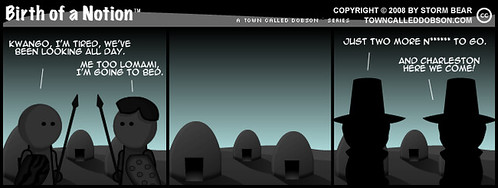 click to enlarge The first Europeans to use African slaves in the New World were the Spaniards who sought auxiliaries for their conquest expeditions and laborers on islands such as Cuba and Hispaniola, where the alarming decline in the native population had spurred the first royal laws protecting the native population. The first African slaves arrived in Hispaniola in 1501. In 1452, Pope Nicholas V issued the papal bull Dum Diversas, granting Afonso V of Portugal the right to reduce any "Saracens, pagans and any other unbelievers" to hereditary slavery. This approval of slavery was reaffirmed and extended in his Romanus Pontifex bull of 1455. These papal bulls came to serve as a justification for the subsequent era of slave trade and European colonialism. The followers of the church of England and Protestants did not use the papal bull as a justification. Increasing penetration into the Americas by the Portuguese created more demand for labor in Brazil--primarily for farming and mining. Slave-based economies quickly spread to the Caribbean and the southern portion of what is today the United States. These areas all developed an insatiable demand for slaves. As European nations grew more powerful, especially Portugal, Spain, France and England, they began vying for control of the African slave trade, with little effect on the local African and Arab trading. Great Britain's existing colonies in the Lesser Antilles and their effective naval control of the Mid Atlantic forced other countries to abandon their enterprises due to inefficiency in cost. The English crown provided a charter giving the Royal African Company monopoly over the African slave routes until 1712. The Atlantic slave trade peaked in the late 18th century, when the largest number of slaves were captured on raiding expeditions into the interior of West Africa. These expeditions were typically carried out by African kingdoms, such as the Oyo empire (Yoruba), Kong Empire, Kingdom of Benin, Kingdom of Fouta Djallon, Kingdom of Fouta Tooro, Kingdom of Koya, Kingdom of Khasso, Kingdom of Kaabu, Fante Confederacy, Ashanti Confederacy, and the kingdom of Dahomey. Europeans rarely entered the interior of Africa, due to fear of disease and moreover fierce African resistance. Before the arrival of the Portuguese, slavery had already existed in Kingdom of Kongo. Despite its establishment within his kingdom, Afonso I of Kongo believed that the slave trade should be subject to Kongo law. When he suspected the Portuguese of receiving illegally enslaved persons to sell, he wrote letters to the King João III of Portugal in 1526 imploring him to put a stop to the practice. The kings of Dahomey sold their war captives into transatlantic slavery, who otherwise would have been killed in a ceremony known as the Annual Customs. As one of West Africa's principal slave states, Dahomey became extremely unpopular with neighboring peoples. Like the Bambara Empire to the east, the Khasso kingdoms depended heavily on the slave trade for their economy. A family's status was indicated by the number of slaves it owned, leading to wars for the sole purpose of taking more captives. This trade led the Khasso into increasing contact with the European settlements of Africa's west coast, particularly the French. Benin grew increasingly rich during the 16th and 17th centuries on the slave trade with Europe; slaves from enemy states of the interior were sold, and carried to the Americas in Dutch and Portuguese ships. The Bight of Benin's shore soon came to be known as the "Slave Coast". Disclaimer:
|
Posted by
Storm Bear
at
6:37 AM
0
comments
![]()
Labels: black history, cartoons, comics, racism, slave trade, slavery, webcomics








